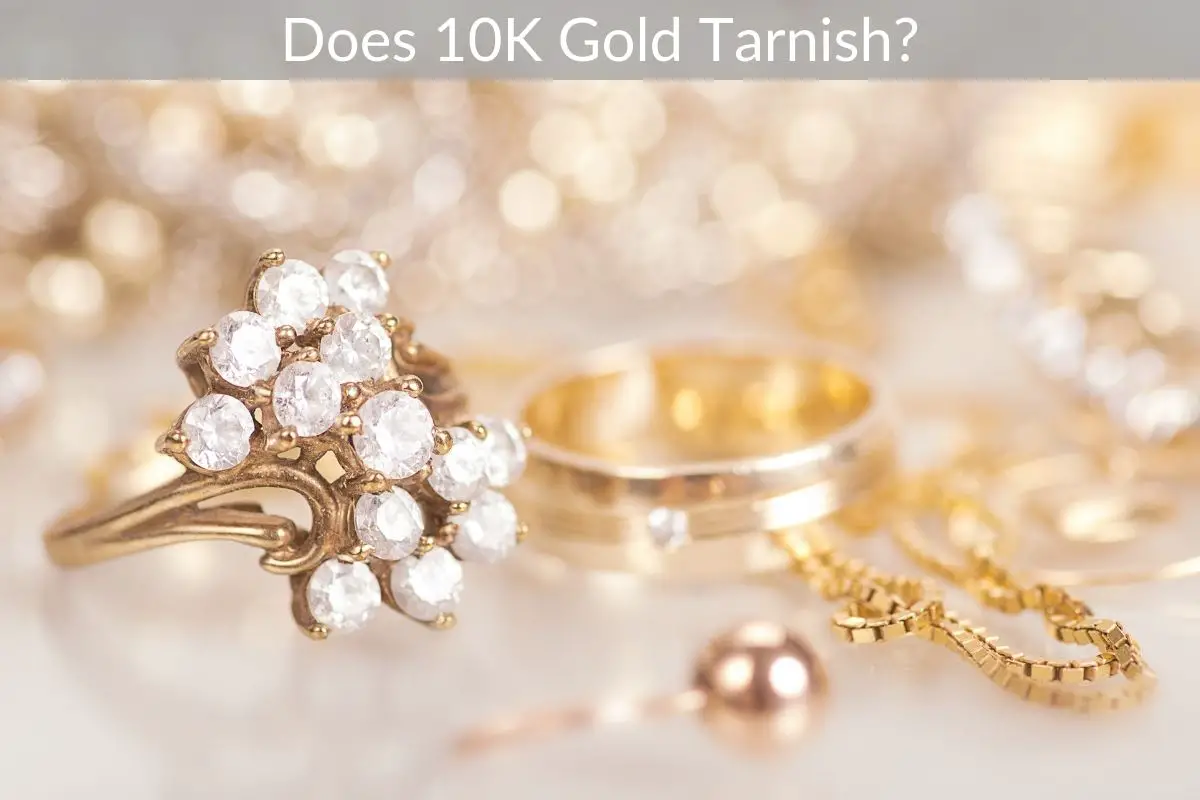Table of Contents
To prevent your gold jewelry or watches from tarnishing or fading, experts recommend storing them in a pouch, case, or jewelry box. The best way to care for your gold jewelry is to store it in a dark, cool, and dry place.
*This post may contain affiliate links. As an Amazon Associate we earn from qualifying purchases.
Avoiding exposure to humidity and heat will protect your gold valuables from tarnishing.
10k gold will tarnish over time since it is not pure gold. However, the tarnish should be relatively easy to keep off or remove if you wish.
Tarnishing is a natural occurrence on all gold that is not pure. Removing tarnish from gold jewelry is easy and inexpensive. However, some people prefer the look of aged (“patina”) gold.
Patina is a thin layer that naturally forms on the surface of copper, brass, bronze, gold, silver, or certain stones. Patina can also be used to describe age on wooden furniture, or any similar acquired change of a surface through age and exposure.
Additionally, the term is used to describe the aging of high-quality leather.
There are four main types of leather: full-grain, top-grain, corrected grain and genuine leather; but only the two highest grades, full-grain and — to a considerably lesser extent — top-grain, will exhibit patina. Vegetable-tanned leather will show a patina, but chrome-tanned leather will usually not.
Leather Patina is something developed through everyday use.
The accumulation of dirt, body oils, sunlight and wear and tear create a slight color change and soft sheen to leather goods. Over time, leather will oxidize and age naturally to give these effects. A patina can make jackets softer while also featuring a lighter, more natural tone.
To see the most popular jewelry cleaners to remove the tarnish or keep your gold jewelry from tarnishing just click here.
How Do You Remove Tarnish From 10K & 14K Gold Jewelry?
Over time, gold can lose its shine or tarnish for a number of reasons. Beauty products like lotion and perfume, as well as oils and sweat from your skin, can dull shiny gold jewelry. Like silver, it’s also possible for gold to tarnish due to humidity and/or heat. The good news is that it’s cheap and easy to remove tarnish from your 10 karat and 14 karat (10K and 14K) gold jewelry:
To remove tarnish from your gold jewelry you simply need to:
- Prepare a mixture of tap water and dishwashing detergent or use a non-abrasive, commercial jewelry cleaner.
- Scrub the tarnish off all surfaces, including crevices of the jewelry, using a toothbrush and soapy water.
- Rinse the jewelry in warm water until the water runs clear.
- Buff the jewelry dry with a soft, lint-free cloth until the jewelry shines.
As mentioned above you can also use a jewelry cleaner that is specifically designed to remove the tarnish from your gold jewelry.
How Do You Remove Tarnish From 14K & 18K Gold Jewelry?
Another option to clean your 14K to 18K gold (not gold filled or gold plated) jewelry is the aluminum foil soak solution. The combination of salt, baking soda and aluminum foil creates ion transfers (a chemical exchange) that naturally cleans the gold.
THIS METHOD IS NOT RECOMMENDED FOR JEWELRY WITH STONES.
Below is how you can remove tarnish from your gold jewelry using this method:
- Line a small bowl with aluminum foil.
- Add 1 tablespoon of salt.
- Add 1 tablespoon of baking soda.
- Heat about a cup of water in a microwave safe container for 2 minutes (Just a reminder, do NOT put aluminum foil in the microwave).
- Add the hot water to the aluminum foil lined bowl with the salt and baking soda solution.
- Soak jewelry in the solution for 10 minutes.
- Remove jewelry from the solution and rub excess debris/tarnish with a soft cloth.
- Rinse jewelry in warm water.
- Dry jewelry with a soft cloth.
Again, this method should not be used on jewelry that has stones in or on it. Only jewelry that is only gold.
Can You Wear 10K Gold In The Shower?
Pure gold does not rust. However, because most gold jewelry is not 100% pure gold the other metals blended with the gold might rust or tarnish. Let’s break down the different karats of gold to see why the higher the karat, the less likely it is to rust:
24K gold is pure gold (“Au” on the periodic table)
18K gold contains 18 parts gold and 6 parts of another metal or metals
14K gold contains 14 parts gold and 10 parts of another metal or metals
12K gold contains 12 parts gold and 12 parts of another metal or metals
10K gold contains 10 parts gold and 14 parts of another metal or metals
24 karat gold is pure gold, which makes it the least likely type of jewelry to rust when exposed to water. On the other end of the spectrum, 10K gold consists of 10 parts gold and 14 parts other metals, usually silver, copper, or zinc, which makes it more likely to rust than 24K, 18K or 14K gold.
Therefore, depending on which gold you’re wearing you might want to remove it before you shower or at least dry it off as soon as you get out of the shower, to keep it looking its best.
It is best to remove any 10k gold jewelry that you have before getting in the shower. It will tarnish over time and the additional exposure to soap, lotion, and water is likely to speed up that process.
Even if you have jewelry that is more pure (18k or 24k) it is still a good idea to remove it when showering so that way you don’t get lotion or soap build ups on it.
What Is The Difference Between 10K, 14K, 18K, And 24K Gold?
The simple answer to the difference between gold karats is that the higher the number of karats, the purer the gold is. So 24k gold is the most pure gold that you can get while any number lower than that has less gold content and more of other types of metal in it.
Here’s a quick chart to visualize the differences:
Chart is from Sacramento Gold & Diamond Buyers
Does 10K Gold Change Color?
In the modern jewelry market there are many types of gold. The three most popular types used in jewelry are: yellow gold, white gold, and rose gold. Each color is made using a slightly different blend of metals that combine with the gold to create different hues.
Yellow gold – or simply, gold – is a natural precious metal. In its purest form it is very soft and bends out of shape easily. That’s why gold used in jewelry will normally be mixed with harder alloy metals.
These help to make the gold more durable, and keep its shape.
White gold is usually an alloy made up of 75% gold and about 25% nickel and zinc.
Rose gold is an alloy made from a combination of pure gold and copper. The blend of the two metals changes the color of the final product. For example, the most common alloy of rose gold is 75% pure gold to 25% copper, which combines to make 18K rose gold.
When you’re buying gold jewelry the most straightforward way to check the karats is to check the surface for markings. If gold jewelry is stamped 18 karat, it was created with 75% pure gold. If you see a 10K or 10KT stamp, it means the gold is 10 karats.
However, the purity of the gold may not be expressed in karats but in percentages or parts per thousand. In that case, the stamp would read “.75”, “750” or a similar number, implying that the piece contains 75% gold, which converts to 18K. There is also a possibility that gold jewelry sold as 18 karats might have no markings at all or, even less likely, the gold is marked 18K, but has a lower purity.
If you’re curious about the gold content of a piece of jewelry or watch, a jeweler can conduct an acid test for a fee.
To conduct an acid test the jeweler will normally take a small sample from your gold and place it into nitric acid. The chemical reaction changes the color of the alloy which allows a jeweler to determine its gold content.

